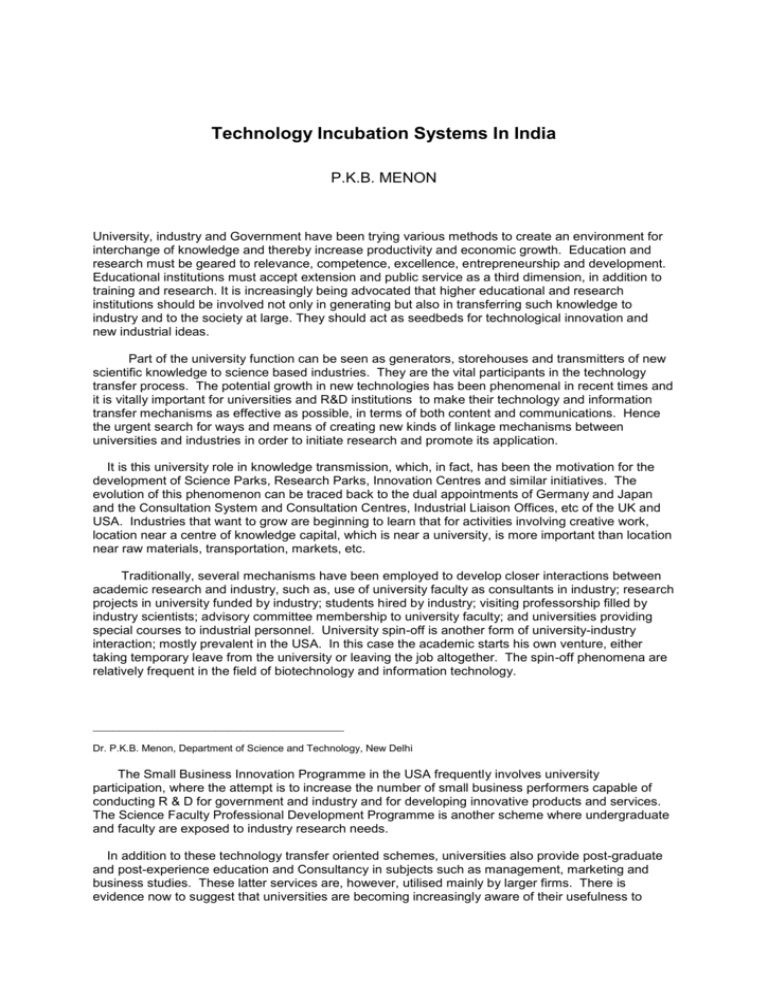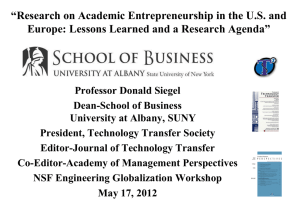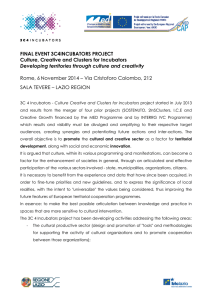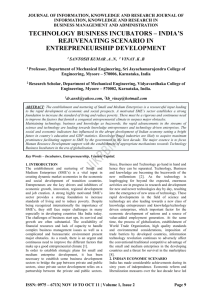TECHNOLOGY INCUBATION SYSTEMS IN INDIA
advertisement

Technology Incubation Systems In India P.K.B. MENON University, industry and Government have been trying various methods to create an environment for interchange of knowledge and thereby increase productivity and economic growth. Education and research must be geared to relevance, competence, excellence, entrepreneurship and development. Educational institutions must accept extension and public service as a third dimension, in addition to training and research. It is increasingly being advocated that higher educational and research institutions should be involved not only in generating but also in transferring such knowledge to industry and to the society at large. They should act as seedbeds for technological innovation and new industrial ideas. Part of the university function can be seen as generators, storehouses and transmitters of new scientific knowledge to science based industries. They are the vital participants in the technology transfer process. The potential growth in new technologies has been phenomenal in recent times and it is vitally important for universities and R&D institutions to make their technology and information transfer mechanisms as effective as possible, in terms of both content and communications. Hence the urgent search for ways and means of creating new kinds of linkage mechanisms between universities and industries in order to initiate research and promote its application. It is this university role in knowledge transmission, which, in fact, has been the motivation for the development of Science Parks, Research Parks, Innovation Centres and similar initiatives. The evolution of this phenomenon can be traced back to the dual appointments of Germany and Japan and the Consultation System and Consultation Centres, Industrial Liaison Offices, etc of the UK and USA. Industries that want to grow are beginning to learn that for activities involving creative work, location near a centre of knowledge capital, which is near a university, is more important than location near raw materials, transportation, markets, etc. Traditionally, several mechanisms have been employed to develop closer interactions between academic research and industry, such as, use of university faculty as consultants in industry; research projects in university funded by industry; students hired by industry; visiting professorship filled by industry scientists; advisory committee membership to university faculty; and universities providing special courses to industrial personnel. University spin-off is another form of university-industry interaction; mostly prevalent in the USA. In this case the academic starts his own venture, either taking temporary leave from the university or leaving the job altogether. The spin-off phenomena are relatively frequent in the field of biotechnology and information technology. _______________________________________ Dr. P.K.B. Menon, Department of Science and Technology, New Delhi The Small Business Innovation Programme in the USA frequently involves university participation, where the attempt is to increase the number of small business performers capable of conducting R & D for government and industry and for developing innovative products and services. The Science Faculty Professional Development Programme is another scheme where undergraduate and faculty are exposed to industry research needs. In addition to these technology transfer oriented schemes, universities also provide post-graduate and post-experience education and Consultancy in subjects such as management, marketing and business studies. These latter services are, however, utilised mainly by larger firms. There is evidence now to suggest that universities are becoming increasingly aware of their usefulness to Technology Incubation Systems in India industry and that companies themselves are looking more for help from universities. Both parties are, therefore, actively seeking to develop ways and means of increasing their interaction. The scientific and technical dynamism of a country is determined by the time lag between a major discovery, invention and its translation to an innovation. Technological innovation is generally a dynamic and complex process involving a wide range of activities. Broadly, it includes the basic research, focussed design and targeted development. Software development, costing and marketing are also inevitable components of successful innovations. The process of technical change, to a significant extent, is based on cumulative and incremental effect of small innovations. New technologies are selected through a complex interaction between economic factors, the industry demands and the effect of government policies. The important areas in successful innovation process include: understanding and meeting the needs of the user, effective internal coupling between R&D and market needs, effective linkage with external sources of S&T expertise, committed entrepreneurs, efficient after sales service and training of the user. The growth of scientific and technological culture in India has played an important role in attracting world attention to indigenous capabilities. Today, India has a vast S&T infrastructure with more than 400 National Laboratories, over 200 Universities including institutes of technology, and about 1300 in-house R&D units in the industrial sector. Indigenous efforts have enabled the country to make considerable progress not only in developing local capabilities but also in adopting and adapting exotic technologies. Six Science Departments have been set up under the Government of India to focus developments in the respective areas. The most radical form of innovation, the creation of new products using new technologies, often requires new organisational structure, innovative financing support systems and encouraging policies of the government. STEP Concept The National Science and Technology Entrepreneurship Development Board (NSTEDB) initiated the Science and Technology Entrepreneurs Park (STEP) programme in 1984 with the following major objectives: To forge a close linkage between Universities/ academic institutions on the one hand and industry on the other. To promote entrepreneurship among S&T persons. To provide R&D support and other facilities to small-scale industries. STEP provides a re-orientation in approach to innovation and entrepreneurship involving education, training, research, finance, management and government. It creates the necessary climate for innovation; for sharing of ideas, experience and facilities and opens up avenues for students, teachers, researchers and industrial managers to grow in a common trans-disciplinary culture, each understanding and depending on others' inputs for starting a successful economic venture. The task, therefore, is to create an "employer culture" where increasingly S&T people will seek to create their own employment. It also involves changing the existing attitude of seeking wage employment and look for a career in small business. To create an impact on this situation requires changes in the educational curriculum, in the way in which occupational choice is developed, in the way in which career advice is given and ultimately the role of small scale sector in wealth generation. Selection of STEP locations: 2 Technology Incubation Systems in India The criteria for selection of STEP locations are based on the following: The presence of a strong S&T orientation and a nucleus of R&D activity in the host institution; i) The development of a comprehensive well thought out plan; ii) Compatibility amongst the industrial operations included in the STEP; iii) Compatibility between STEP and the host institution activities; Shared central services; iv) Easy access to host institution facilities., v) The existing relationship between the academic institution and industry. Present Status of STEPs The NSTEDB, jointly with the all India Financial Institutions (Industrial Development Bank of India (IDBI), Industrial Finance corporation of India (IFCI), Industrial Credit and Investment Corporation of India (ICICI) have so far established 15 STEPs in different parts of the country. Each STEP has been established as an autonomous registered society having an independent legal status, which is external to the administrative structure of the host institution. Each STEP also follows its own particular model depending on the local environment and needs. Thrust areas in technology development and commercialization have also been identified, based on the strength of the host institution and the industrial milieu existing in the vicinity. The number of start-up units, technologies developed and employment generated by the STEPs are given below: (As on March 1999)* SL NO STEP NUMBER OF UNITS LOCATION 1 Mysore 2 3 4 TECHNOLOGIES EMPLOYMENT DEVELOPED 95 17 Trichy 106 26 1100 Kharagpur Ranchi 31 60 59 60 313 695 5 6 Pune Roorkee 25 14 60 40 160 150 7 8 Ludhiana Kanpur 95 31 53 10 680 200 9 Mumbai 45 0 200 10 11 Bhopal Suratkal 46 50 8 4 148 450 3 800 Technology Incubation Systems in India 12 Coimbatore 6 3 18 13 Patiala 1 0 5 2 STEPs are new The facilities available in the STEP for use by the entrepreneurs and the services offered are as follows: FACILITIES AVAILABLE SERVICES OFFERED Incubation Space Testing and Calibration Testing and Calibration Central Workshop Consultancy Research Prototype Development Training Computing Data Bank Software Product Development Library & Documentation Seminar Hall/Conference Room Process Development Human Resources Common Facilities such as Telephone, Fax, Telex, e-mail, Reprography etc. Technical Support Business Facilitation Pollution Control Laboratory Common Utility Pilot Plant Facility Quality Assurance Center Bureau of Indian Standards Ext. Escorting to ISO Patent Facility Center Profiles of STEP Entrepreneurs The programme was initiated to promote entrepreneurship among the S&T persons so that a new breed of technology oriented and quality conscious entrepreneurs could be developed. Therefore, it is expected that a large number of the entrepreneurs come from the S&T background. An analysis of the STEP entrepreneurs’ educational qualification indicates that majority of them has a degree in engineering (47%), followed by graduates in science (21%), diploma holders in engineering (21%) and others (11%). The industry wise distribution shows that a majority entered into engineering related business (42%), followed by electronics and IT (18%), chemicals & pharmaceuticals (18%), services (10%) and others (12%). Technology Business Incubator (TBI) The Technology Business Incubator is another mechanism initiated by the NSTEDB to provide advisory, training and information services, management and marketing support, linkages to research faculty and facilities, access to capital, thereby greatly enhancing the chances of success of the early stage technopreneur (Lalkaka, 1996). It is a cost-effective instrument for technology transfer and the development of knowledge-based and high-tech enterprises. The main objective of Technology Business Incubators is to facilitate the technological development stage and to complete technological ideas for technologies currently under development. However, the technology incubators are commonly known to include the concepts of technology business incubators and innovation centers. The goal of technology incubators is also to promote technology-based firms, and to address regional and local developmental issues through S&T. TBIs are located at or near technical institutions and are characterized by institutional links to 4 Technology Incubation Systems in India knowledge sources including technology transfer agencies, research centers, national laboratories and skilled R&D personnel. TBIs promote technology transfer and diffusion while encouraging entrepreneurship among researchers and academics. A TBI is a managed workspace with low cost office facilities and business and professional services necessary for nurturing and supporting early stage growth of technologies and technology based enterprises. The services may include modern communication and information services, and access to the R&D, testing, design and engineering etc., facilities and services. The objective is to cover some of the risks involved in the early stages of incubation of technologies and technopreneurs particularly in the area of high technologies. In addition to work space, the services provided by incubators can include various forms of business planning and managerial advice, office facilities, finance and accounting access to business networks, and legal services. TBIs essentially assume (Bischoff Jurgen, 2000): Strong R&D and technological capabilities in academic institutions and R&D organisations, thereby associating R&D results with commercial potential and encouraging potential entrepreneurship among students and faculty. Potential technopreneurs including researchers, who are willing to translate their ideas/high technology into products and services, are available. Strong linkages with academic and financial institutions. Some of the major objectives of establishing TBIs are: Technology Commercialisation: Most universities, R&D institutions and technical institutions such as IITs have technologies, which needs to be commercialized. These institutions are indeed a critical element in the supply of future business know-how for industry. Economic Development: TBIs are a tool for promoting new business. A main underlying goal of support for new business formation is economic development through job generation. Property Venture: TBIs create lucrative property based venture. Entrepreneurship Development: Promoting entrepreneurship through incubators is another objective of public support. One of the main goals of technology incubators in developing countries and transit economies has been the development of an entrepreneurial culture and the creation of SMEs. Incubators in the university premises can act as a training ground for entrepreneurs, especially the technoentrepreneurs. R&D for Industry: Creating awareness among academic institutions about the requirements of industry and reorient their research and development programmes to suit the need of industry. Problem Solving: Act as a problem-solving agency not only in the areas of technology but also in other related areas of business development. India has formulated a scheme under the aegis of the National Science and Technology Entrepreneurship Development Board to set up Technology Business Incubators in the country. An Information Technology Business Incubator has already been set up in NOIDA, close to New Delhi. Under support from UNDP sponsored program on Technology Management, it is proposed to set up two TBIs. In addition, several privately managed incubators are being set up in different parts of India. 5 Technology Incubation Systems in India Conclusions Effective Planning and execution alone would not make STEP/TBI a success. The presence of an outstanding R&D institution alone does not cause the development of high technology industries. The STEP/TBI and the host institution are envisaged as a service function that can strengthen the trend towards high technology business and entrepreneurship, but they cannot create the trend. If STEPs/TBIs are to be of significant value in promoting industries and generating jobs, the economic and cultural seedbeds need careful preparation to receive the entrepreneurial seed. important factors that can affect STEP/TBI movement are: Freedom given to the S&T community to enter into this activity; Availability of financial support; An industrial cultural milieu. The three The government, financial institutions and university all have a significant role to play in creating an environment conducive to the growth of STEPs/TBIs and high technology industries. At the same time, STEPs/TBIs alone are not sufficient to stimulate advanced technology development. Rather, STEPs/TBIs are one of the services that the community possesses to create a growing, advanced technology industry. Various other complementary methods of university – industry linkages have also to be developed. REFERENCES 1. Rustam Lalkaka (1996) Technology Business Incubators: Critical Determinants of Success. Annals of the New York Academy of Sciences, vol. 798, 1966 2. Bischoff Jurgen (2000) Project Selection, Monitoring and Evaluation for technology Incubation in Developing Countries. Regional Consultative Meeting on Strengthening Technology Business Incubators Systems for Creating High Technology based Enterprises, 29-31, August 2000, Seoul, and Republic of Korea. 6










